
USS Blueback (SS-581) is a decommissioned Barbel-class submarine formerly in the United States Navy. She was the second Navy submarine to bear the name.

United States Fleet Activities Yokosuka or Commander Fleet Activities Yokosuka is a United States Navy base in Yokosuka, Japan. Its mission is to maintain and operate base facilities for the logistic, recreational, administrative support and service of the U.S. Naval Forces Japan, Seventh Fleet and other operating forces assigned in the Western Pacific. CFAY is the largest strategically important U.S. naval installation in the western Pacific.
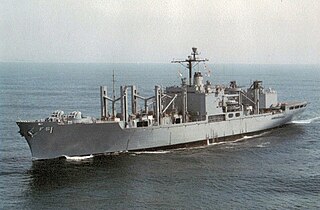
USS Mars (AFS‑1), the third United States Navy ship to bear the name, was laid down by the National Steel and Shipbuilding Company in San Diego, California, on 5 May 1962; launched on 15 June 1963, sponsored by Mrs. Clyde Doyle, widow of Representative Clyde Doyle of California; and commissioned at Long Beach Naval Shipyard on 21 December 1963, with Captain Russel C. Medley in command.
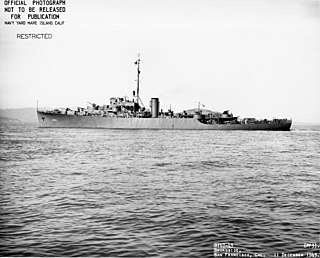
USS Tacoma (PG-111/PF-3), the lead ship of the Tacoma-class patrol frigates. The third ship of the United States Navy to be named for Tacoma, Washington, she was in commission from 1943 to 1945, and from 1949 to 1951. She also served in the Soviet Navy as EK-11 and in the Republic of Korea Navy as ROKS Taedong (PF-63).
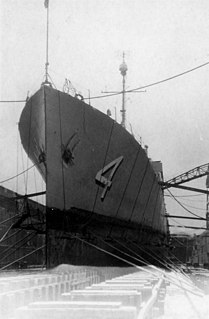
USS Sausalito (PF-4), was a Tacoma-class patrol frigate in commission from 1944 to 1945 and from 1950 to 1952, was the only ship of the United States Navy to be named for Sausalito, California. She also served in the Soviet Navy as EK-16 and in the Republic of Korea Navy as ROKS Imchin (PF-66).
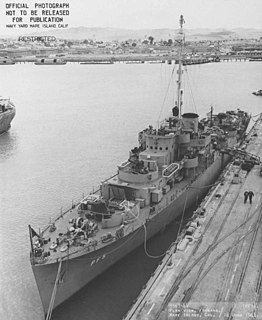
USS Hoquiam (PG-113/PF-5), a Tacoma-class patrol frigate in commission from 1944 to 1945 and from 1950 to 1951, she is the only ship of the United States Navy to be named for Hoquiam, Washington. She also served in the Soviet Navy as EK-13 and in the Republic of Korea Navy as ROKS Nae Tong (PF-65).

U.S. Naval Forces Japan/Navy Region Japan (CNFJ/CNRJ) is a dual-hatted command with command and control authority of all shore installations and assigned forces of the United States Navy in Japan as well as the responsibility to liaise with the Japanese Maritime Self-Defense Force (JMSDF). It is currently headquartered in Yokosuka, Japan, onboard United States Fleet Activities Yokosuka and is commanded by Rear Admiral Brian P. Fort, USN. CNFJ/CNRJ's area of responsibility extends from the southern tip of the Kamchatka peninsula to the northern tip of Taiwan, the Singapore area of operations, and the British Territory of Diego Garcia, but excludes the Korean peninsula.
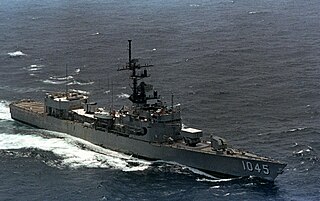
USS Davidson (FF-1045) was a Garcia-class destroyer escort, and later a frigate, in the United States Navy. She was named for Vice Admiral Lyal A. Davidson. Davidson was commissioned with the US Navy from 1965 to 1988 and served with the Brazilian Navy from 1989 to 2002. Davidson sank while under tow to be scrapped in India circa in 2005.

The fourth USS Worden (DLG/CG-18), a Leahy-class cruiser, was a ship of the United States Navy named in honor of Admiral John L. Worden. Originally called a "destroyer leader" or frigate, in 1975 she was redesignated a cruiser in the Navy's ship reclassification. The ship entered service in 1963 and participated in the Vietnam War.
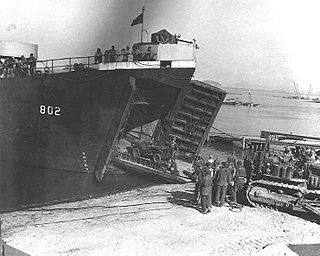
USS Hamilton County (LST-802) was an LST-542-class tank landing ship built for the United States Navy during World War II. Named after counties in Florida, Illinois, Indiana, Iowa, Kansas, Nebraska, New York, Ohio, Tennessee, and Texas, she was the only U.S. Naval vessel to bear the name.

USS Silverstein (DE-534) was a John C. Butler-class destroyer escort in service with the United States Navy from 1944 to 1947 and from 1951 to 1958. She was sold for scrapping in 1973.

United States Naval Hospital Yokosuka Japan with its eight branch clinics are US Navy medical treatment facilities catering to the medical needs of eligible Sailors, Marines, Soldiers, Airmen, family members, U.S. government employees, retired military service members and other eligible beneficiaries of the Forward Deployed Naval Forces on mainland Japan, Korea and Diego Garcia. The core hospital is located on board Commander Fleet Activities Yokosuka with branch clinics serving Naval Air Facility Atsugi, Combined Arms Training Center Camp Fuji, Commander Fleet Activities Chinhae Korea, Naval Support Activity Diego Garcia, Marine Corps Air Station Iwakuni and Commander Fleet Activities Sasebo.

USS Gardiners Bay (AVP-39) was a United States Navy seaplane tender in commission from 1945 to 1958 that saw service in the latter stages of World War II and in the Korean War. After her decommissioning, she was transferred to Norway, and she served in the Royal Norwegian Navy as the training ship HNoMS Haakon VII (A537) from 1958 to 1974.

USS Burlington (PF-51) was a Tacoma-class frigate in commission from 1944 to 1945 and from 1951 to 1952, the only United States Navy ship thus far to have been named for Burlington, Iowa. She also served in the Soviet Navy as EK-21 and in the Colombian National Armada as ARC Almirante Brión.
This is a list of Imperial Japanese Navy bases and facilities

Operation Tomodachi was a United States Armed Forces assistance operation to support Japan in disaster relief following the 2011 Tōhoku earthquake and tsunami. The operation took place from 12 March to 4 May 2011; involved 24,000 U.S. servicemembers, 189 aircraft, 24 naval ships; and cost $90 million.

USS Woodpecker (AMS/MSC-209) was a Bluebird-class minesweeper of the United States Navy, that saw service during the Vietnam War, and was later sold to the Republic of Fiji where she served as HMFS Kikau (MSC-204).

Naval Computer and Telecommunications Station Guam is a United States Navy communications facility on the U.S. territory of Guam. It is located on the Naval Base Guam North Finegayan Telecommunications Site along Guam Highway 3 in Dededo, on the northwest coast of the island. NCTS Guam is under the United States Tenth Fleet's Naval Computer and Telecommunications Area Master Station Pacific and under the installation management authority of Joint Region Marianas. It has been variously referred to as Naval Communications Station Guam, NCS or NCTS Finegayan, and North Finegayan.
















